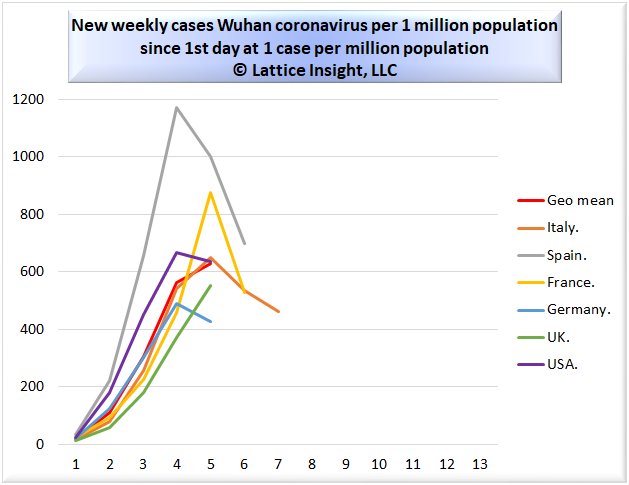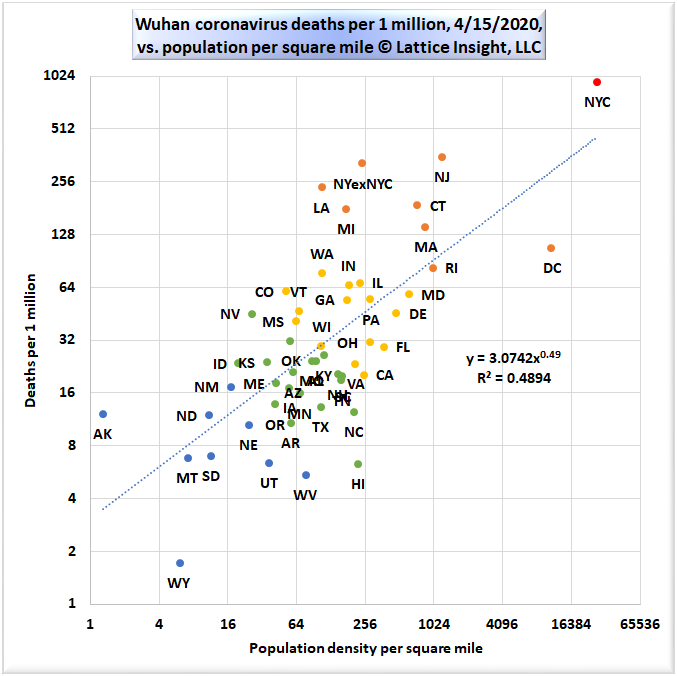Six hundred. Six zero zero. That is the approximate number of jobs destroyed in the United States, so far, for every American life lost to the Wuhan coronavirus, so far.
As of April 16, 2020, about 34 thousand Americans have died with Wuhan coronavirus. Under CDC guidance, coronavirus does not have to be known as the principal cause of death. Indeed, the decedent need not have tested positive for the disease, as long as coronavirus is presumed or suspected to have been present.
In the 1957-58 Asian flu pandemic, about 100 thousand Americans died from the flu, in a country with about half the population of today's America. That is equivalent to about 200 thousand deaths today. The 2017-18 flu epidemic killed about 61 thousand Americans, for comparison.
America's response to the current pandemic has been to shut down the economy, and in some states, to put citizens under virtual house arrest. Moralizing politicians and health experts insist that the lockdown continue nationally until there are no new cases for two straight weeks. America suffers about 7700 deaths each day already, including some from infectious disease (and some from medical error...), but never has there been such a drastic response to a disease that kills far fewer children than the flu.
The following graphic shows the progress of new cases of Wuhan coronavirus in the six most affected countries, in weekly number of news cases per one million population, measured from the first day on which total cases numbered at least one per one million population. All countries hit their peaks during week 4 or week 5. America is past the peak of new cases. ("Geo mean" refers to the geometric mean of the six time series.)
As of April 16, 2020, about 34 thousand Americans have died with Wuhan coronavirus. Under CDC guidance, coronavirus does not have to be known as the principal cause of death. Indeed, the decedent need not have tested positive for the disease, as long as coronavirus is presumed or suspected to have been present.
In the 1957-58 Asian flu pandemic, about 100 thousand Americans died from the flu, in a country with about half the population of today's America. That is equivalent to about 200 thousand deaths today. The 2017-18 flu epidemic killed about 61 thousand Americans, for comparison.
America's response to the current pandemic has been to shut down the economy, and in some states, to put citizens under virtual house arrest. Moralizing politicians and health experts insist that the lockdown continue nationally until there are no new cases for two straight weeks. America suffers about 7700 deaths each day already, including some from infectious disease (and some from medical error...), but never has there been such a drastic response to a disease that kills far fewer children than the flu.
The following graphic shows the progress of new cases of Wuhan coronavirus in the six most affected countries, in weekly number of news cases per one million population, measured from the first day on which total cases numbered at least one per one million population. All countries hit their peaks during week 4 or week 5. America is past the peak of new cases. ("Geo mean" refers to the geometric mean of the six time series.)
The following graphic shows the strong relationship between Wuhan coronavirus deaths per one million population, and population density. The data points are the 50 states plus DC. However, New York state has been separated into two components: New York City, and the remainder of the state. It is remarkable that R-squared for this power-law model is nearly 49%. Remove Alaska from the data set, and R-squared increases to about 51%.
The implication is clear: high population density is a risk factor for Wuhan coronavirus mortality. The relationship would most likely be stronger still if it were plotted by county rather than by state; the hardest hit counties in America are also the most densely populated.
The above graphic depicts data points, the states, filled in according to a color spectrum, in which the lowest risk states are blue, and the highest risk locations are red. This graphic justifies today's proposal for re-opening America, announced today by the White House Coronavirus Task Force. Decisions should be made, not just state-by-state, but even on a county-by-county basis.
America runs a terrible danger if we continue in the one-to-two-year lockdown proposed by some elites. It is not possible to turn on an economy like a light switch. Unemployment is devastating to individuals and to families; to have it running at depression-era levels would be a disaster.
The elites may believe that food grows in the stock room at Whole Foods, but the reality is far more complex. If farmers are not able to harvest their winter wheat and plant a spring crop, we could experience famine on a communist scale.
Stay-at-home orders do not add value to the benefits of social distancing, according to the studies I have read. The recommendations thus seem clear: allow businesses to re-open; allow people to travel as they wish; but wear face masks in a relatively crowded space, and wash frequently. This strategy has worked successfully in eastern Asian countries, and can work here, until a vaccine becomes available.
America will not remain forever in isolation, jobless and starving. It is time to re-open, cautiously, now.
The above graphic depicts data points, the states, filled in according to a color spectrum, in which the lowest risk states are blue, and the highest risk locations are red. This graphic justifies today's proposal for re-opening America, announced today by the White House Coronavirus Task Force. Decisions should be made, not just state-by-state, but even on a county-by-county basis.
America runs a terrible danger if we continue in the one-to-two-year lockdown proposed by some elites. It is not possible to turn on an economy like a light switch. Unemployment is devastating to individuals and to families; to have it running at depression-era levels would be a disaster.
The elites may believe that food grows in the stock room at Whole Foods, but the reality is far more complex. If farmers are not able to harvest their winter wheat and plant a spring crop, we could experience famine on a communist scale.
Stay-at-home orders do not add value to the benefits of social distancing, according to the studies I have read. The recommendations thus seem clear: allow businesses to re-open; allow people to travel as they wish; but wear face masks in a relatively crowded space, and wash frequently. This strategy has worked successfully in eastern Asian countries, and can work here, until a vaccine becomes available.
America will not remain forever in isolation, jobless and starving. It is time to re-open, cautiously, now.


 RSS Feed
RSS Feed